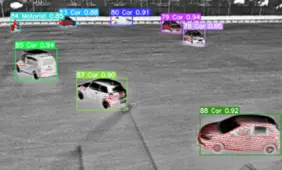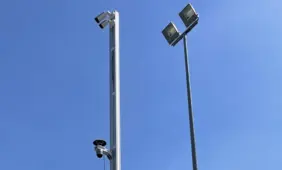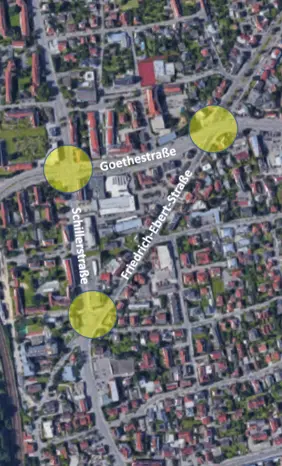The civil engineering work has already begun, and the sensors will be installed at the beginning of May. In order to research ways to better control traffic in Ingolstadt and make it safer, a so-called High Definition Test Field (HDT) is currently being built as part of the project "Künstliche Intelligenz im Verkehrssystem Ingolstadt" (KIVI). The Institute for Automated Driving (C-IAD) at Ingolstadt University of Applied Sciences (THI) is setting up this test field with the support of the project partners AININ gGmbH, Fraunhofer Institute for Transportation and Infrastructure Systems IVI and the City of Ingolstadt. The project team thus combines expertise from the fields of automated driving and road safety (C-IAD), AI algorithms for sensor technology (AININ), communication technology (Frauenhofer IVI) and urban infrastructure (Stadt Ingolstadt).
At the highly congested junctions Goethestraße/Schillerstraße, Goethestraße/Friedrich-Ebert-Straße and Schillerstraße/Friedrich-Ebert-Straße, LiDAR sensors with special software and thermal cameras will soon record all road users in real time. However, data protection is assured with the system. "Neither system is capable of collecting personal data," explains Prof. Dr.-Ing. Werner Huber, project manager at the HDT. Rather, the sensors detect how a vehicle or pedestrian moves through the intersection over time. The data obtained will then be used as early as this summer to explore potentials for optimising traffic flow and increasing road safety.
Since 2021, the system has been tested in a physical twin on the CARISSMA outdoor site. Now, over the next few months, the aim is to investigate how artificial intelligence can be used to optimise traffic light times for motorists, cyclists and pedestrians in this intersection triangle. In addition to less waiting time, the project also focuses on safety. "The first application to be implemented using the data is an intelligent warning system designed to defuse critical situations in the intersection at an early stage," explains Werner Huber. For this purpose, warning displays will be installed that, when an imminent conflict between vehicles and cyclists is identified, will alert road users and call for accident-avoidance action.
The project is being funded by the Federal Ministry for Digital and Transport (Bundesministerium für Digitales und Verkehr) with up to 6.95 million euros as part of the promotion of artificial intelligence applications in mobility. The engineering firm VCM from Munich is accompanying the planning and constructional implementation.





![[Translate to English:] Logo Akkreditierungsrat: Systemakkreditiert](/fileadmin/_processed_/2/8/csm_AR-Siegel_Systemakkreditierung_bc4ea3377d.webp)








![[Translate to English:] Logo IHK Ausbildungsbetrieb 2023](/fileadmin/_processed_/6/0/csm_IHK_Ausbildungsbetrieb_digital_2023_6850f47537.webp)


